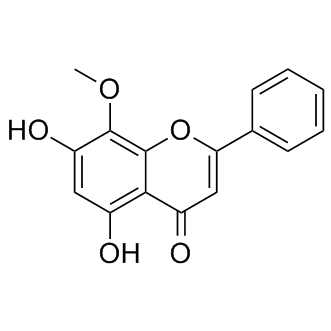| Cas No.: | 632-85-9 |
| SMILES: | O=C1C2=C(OC(C3=CC=CC=C3)=C1)C(OC)=C(O)C=C2O |
| Formula: | C16H12O5 |
| M.Wt: | 284.26 |
| Purity: | >98% |
| Sotrage: | 4°C for 1 year, -20°C for more than 2 years |
| Description: | Wogonin is a naturally occurring mono-flavonoid, can inhibit the activity of CDK8 and Wnt, and exhibits anti-inflammatory and anti-tumor effects. |
| Target: | CDK8 Wnt |
| In Vivo: | Wogonin (30, 60 mg/kg) reduces tumor growth of HCT116 cells in a xenograft model[1]. Wogonin (25, 50, 100 mg/kg) protects against liver injury and pathological characteristics of ALD in mice. Wogonin activates PPAR-γ expression in mice with ALD and EtOH induced RAW264.7 cells[3]. |
| In Vitro: | Wogonin (0-200 μM) exhibits a dose- and time- dependent reduces in cell viability of caco-2, SW1116 and HCT116 cells. Wogonin (10-40 μM) induces G1 phase arrest in HCT-116 cells. Wogonin also supresses Wnt signaling pathway in HCT116 cells. Wogonin interfers in the activity of transcription factor TCF/Lef family. Moreover, Wogonin inhibits β-catenin-mediated transcription through suppressing the activity of CDK8[1]. Wogonin shows cytotoxic and antiproliferative effects on HeLa cells. Wogonin (90 µM) induces cell cycle arrest at G0-G1 phase, and suppresses the levels of cyclin D1 and Cdk4 markedly in HeLa cells[2]. Wogonin (1.25, 2.5, 5, 10, 20 μg/ml) suppresses EtOH-induced inflammatory response in RAW264.7 cells[3]. |
| Cell Assay: | HCT116 cells are planted on a 96-well plate (1 × 105 cells per well). Different concentrations of wogonin are added and incubated for 24 h. Subsequently, 20 μL of MTT solution (5 mg/mL) is transferred to each well and the plates are incubated for 4 h at 37°C and 5% CO2. The supernatant is aspirated off and 100 μL DMSO is added to dissolve the formazan crystal. The mixture is shaken and measured at 570 nm using a universal microplate reader. |
| Animal Administration: | C57BL/6 mice, male, 6-8 weeks old, weighing 18-22 g mice are housed at comfortable environment and are acclimatized for 3 days before the experiment. A total of 48 mice are randomLy divided into six groups of 8 animals, respectively control diet (CD)-fed mice, EtOH-fed mice, wogonin-treated mice at the dose of 25, 50, 100 mg/kg/day and the positive (dexamethasone, 1 mg/kg/day)-treated mice. Modeling process has a total of 16 days including a liquid diet adaptation period for 3 days and modeling for 13 days. The EtOH-fed mice are fed containing 5% v/v ethanol liquid diets adding certain vitamin and choline for 16 days, and mice are gavaged with a single binge ethanol administration (5 g/kg, body weight, 20% ethanol) at last day. At the same time, the wogonin-treated mice and the positive-treated mice are not only plus the ethanol administration, but also plus the medicines by gavage daily, whereas the CD-fed mice are fed with control liquid diets and gavaged with isocaloric maltose-dextrin at last day. All diets are prepared fresh daily. 9 h after the last gavage alcohol, mice are sacrificed under anaesthesia, the liver tissues and blood are collected for further analysis. |
| References: | [1]. He L, et al. Wogonin induced G1 cell cycle arrest by regulating Wnt/β-catenin signaling pathway and inactivating CDK8 in human colorectal cancer carcinoma cells. Toxicology. 2013 Oct 4;312:36-47. [2]. Yang L, et al. Wogonin induces G1 phase arrest through inhibiting Cdk4 and cyclin D1 concomitant with an elevation in p21Cip1 in human cervical carcinoma HeLa cells. Biochem Cell Biol. 2009 Dec;87(6):933-42. [3]. Li HD, et al. Wogonin attenuates inflammation by activating PPAR-γ in alcoholic liver disease. Int Immunopharmacol. 2017 Sep;50:95-106. |

 To enhance service speed and avoid tariff delays, we've opened a US warehouse. All US orders ship directly from our US facility.
To enhance service speed and avoid tariff delays, we've opened a US warehouse. All US orders ship directly from our US facility.




















